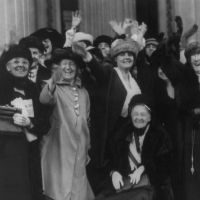
On August 18, 1920, the Tennessee state legislature approved the Nineteenth Amendment to the Constitution by a nail-biting margin of one vote. The Volunteer State was the 36th state to approve the amendment, and having met the constitutional requirement of approval by three-quarters of the states, the amendment was ratified. Suffragists across the nation celebrated this long and hard-fought victory.
Two years later, 87-year-old Rebecca Felton of Georgia, a Democrat, became the first woman to serve in the U.S. Senate. Appointed to fill a vacancy, Felton took the oath on November 21, 1922. She gave only one speech in the Senate Chamber, but her brief tenure tore down a long-standing barrier to women. Felton predicted a new day for women in politics. “When the women of the country come in and sit with you . . . , you will get ability, you will get integrity . . . and you will get unstinted usefulness.”

Even before Felton took office, women had already left their mark on Senate history. In fact, women have always been a part of the Senate’s story, influencing its members and guiding its actions as petitioners, activists, correspondents, spouses, witnesses, lobbyists, speakers, and most importantly, as staff and then as senators. To commemorate the centennial of the Woman Suffrage Amendment, ratified in 1920, and to acknowledge the service of the first woman senator in 1922, the Senate Historical Office celebrates the evolving role of the Women of the Senate.
Since the Senate opened its doors to the public in 1795, women have been a near-constant presence in and around the Chamber. Margaret Bayard Smith was an avid writer of letters who began writing for the National Intelligencer, Washington, D.C.’s first newspaper, in the 1820s. An articulate observer of the Senate's early years, Smith's accounts of the dramatic exchanges between Senators Daniel Webster and Robert Hayne provided a richly detailed portrait of this historic debate. In addition to chronicling Senate debates, women have played pivotal roles in shaping them, such as petitioning to abolish slavery and demanding women’s right to vote, among other issues.
Spouses have been active political participants, engaging with elected members and the nation in a variety of ways. During World War I, for example, Senate wives formed a local Red Cross branch to support U.S. troops, rolling bandages and assisting local hospitals. After the war, the Ladies of the Senate expanded their mission to include other charitable work. Today, Senate spouses—including the husbands of women senators—maintain a connection with the Red Cross and pursue a variety of activities, including hosting an annual luncheon for the First Lady. Senate spouses continue to play an important role in the Senate of the modern era, not only as partners in Senate families, but also as active, dynamic, and influential actors in the American political system.

By the time Felton took office in 1922, a growing number of pioneering women had assumed top staff positions on committees and in senators’ offices. One of those pioneers, Leona Wells, joined the Senate's clerical staff on January 14, 1901, and remained on the payroll for the next 25 years. Today, women hold many important and influential positions in the Senate. They work for committees and in members’ offices, as elected officers, policymakers, legal counsel, and staff directors. They also support the institution’s daily operations, serving on the Capitol Police force, for example, in Senate dining facilities, in building maintenance, as Senate curators and historians, and in a variety of other positions.

Felton’s historic Senate appointment paved the way for other women senators. Hattie Caraway of Arkansas became the first woman to win election to the Senate in 1932. In 1949 Margaret Chase Smith of Maine took the oath of office, becoming the first woman to serve in both the U.S. House of Representatives and the Senate. In the 21st century, women’s growing influence in politics is seen daily in the Senate Chamber, where a record number of women currently serve as U.S. senators.
Fifty-seven women have served in the United States Senate since the first woman took the oath of office in 1922. To capture some of their varied experiences, document the challenges they faced, and record their unique perspectives on social and political issues of the day, Senate historians have conducted oral history interviews with former women senators and staff. Their stories are central to understanding Senate history. They provide a fuller, richer understanding of the evolving role of women in the Senate and their impact on the institution and the country.
The Senate Historical Office continues its Women’s Suffrage Centennial series with its new online commemorative exhibit Women of the Senate.